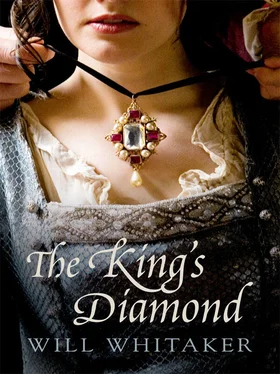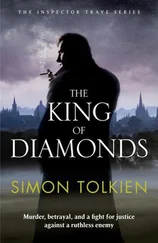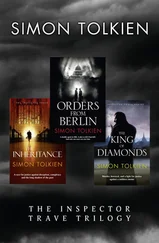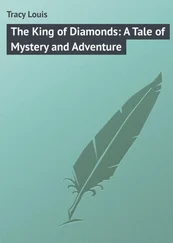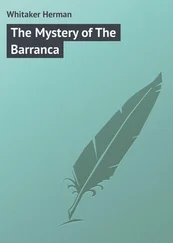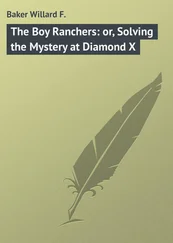Will Whitaker
The King’s Diamond

For Elizabeth and Alexander
Historical Note
Prologue
Part 1
Topaz: a Perfect Sunshine Stone
1
Hammers rang on anvils, and sparks sprayed from the forges…
2
It was seven months since I had set foot in…
3
As I grew older, I used to slip away whenever…
4
Six weeks later I was standing in the steerage house…
5
For the moment, I was content to obey my mother.
Part 2
Scythian Emerald: a Courtesan among Stones
6
A month later I stepped up on to the great…
7
I went home euphoric. The smell of Ippolita was still…
8
We walked swiftly back up from the fish market, with…
Part 3
Chrysoprase: the Lantern in the Darkness
9
On a grey, drizzling morning towards the end of January…
10
Day by day, I watched in impatience as Cellini worked.
11
Next afternoon I set out with Cellini down the Via…
12
‘Are you completely and utterly out of your mind?’
13
I lay that night in my bed at the inn…
14
As I came away from the Palazzo del Bene it…
Part 4
The Golconda Diamond: a Thorn in the Heart
15
Light fell slantwise from the plain glass windows of the…
16
There was dinner, most days, in the Palazzo del Bene.
17
For two days we wound up the valley of the…
18
That very night we rode from Florence, west into the…
Part 5
Ruby of Serendip: a Stone to Heat the Blood
19
The next day Renzo da Ceri was seen in his…
20
It was easy going at first. The current did not…
21
I would have been dead already, if it had not…
22
Still the Sack continued, and the soldiers grew all the…
23
I grabbed her hand, wiping it clean, weeping, touching her…
24
I let Hannah step out of the storeroom first. When…
Acknowledgements
About the Author
Credits
Copyright
About the Publisher
It is 1527. The young Emperor Charles V, the most powerful monarch in centuries, rules much of Europe from his capital, Madrid, and is extending his empire in a series of ruthless wars. In Rome, the wily Medici Pope Clement VII has formed an alliance to fight Charles and drive his armies out of Italy for good.
As the powers of Europe take sides in the great struggle, only England holds aloof. King Henry VIII, at the age of thirty-six, is the most glamorous and accomplished monarch of Christendom: dancer, jouster, sportsman, musician, scholar. His Court is a place of untold opulence. He has no intention of involving himself in the Pope’s quarrels. Instead his thoughts are on a woman: beautiful and beyond his reach.
6 May 1527
The Sack of Rome
He sat and gazed upon the stone. Its surface was smooth and undulating, virgin and uncut as when it first came from the mine. Over it lay a soft and milky sheen, pretty, teasing, allowing no glimpse of what lay inside. To one without experience, it would not have appeared to be a rough diamond at all.
He turned the gem in his fingers until the light suddenly penetrated, and for an instant he had a perfect view into its depths. He saw the tiny flaw that reached down, just off-centre, like a hand plunged into cold water, white against the pale blue transparency of the stone. The ray of light glanced off the flaw and dived deeper, acquiring more intense tints of marine blue and peach-bloom. It lingered on the gem’s lower surface, mellowing now, growing frail but exquisite, like the flavours of an old wine. As he turned it a fraction, the light broke, and the timid, beautiful blue exploded with animal wildness into orange, vermilion, carmine, indigo, the turquoise of burning sulphur. The whole body of the stone was alive with colours, jarring, leaping, bursting back up and out, ravishing and dazzling his eyes and making him draw in his breath. A moment later the milky veil was drawn once more over its surface, and the stone lay in his hand, mute and composed: gleaming with promise, and yet maddeningly secret and withdrawn. He shivered with exhilaration. No other diamond, and only one woman, had ever hurled him through such a rush of emotions, the teasing seduction, the passion and fulfilment, the coolness, the seeming rejection and despair. He turned the diamond again, seeking once more for that momentary gleam of light, catching it and losing it again, catching it and losing it.
That flaw fascinated him. It was like a scar on the body of an otherwise perfect woman, a part of her nakedness that he loved almost more than the rest. But he must drink his fill of the sight while he could. Soon the flaw must be cut away. There would be risk. Certainly, it was that pale, slender fissure that had frightened off all the diamond’s previous owners from any attempt to cut it. With a rough stone like this, no one could be sure of its properties. You might trim it away to almost nothing, and still find the flaw snaking through its flesh, mocking you. He turned the diamond once more, so that its flaw shimmered in the light. This was a stone among thousands, the stone that would make his fortune: or else bring him to utter ruin.
He thought back to its birth, untold centuries ago. They say that gems are born from seeds, sown by daemons or intelligences underground; the same beings that by their sports create strange effigies in rocks, in the form of shells, bones and trees. The gems grow, slowly over the ages, each in its own secret womb of rock. Rubies in the gleaming red balasse. Emeralds in jasper. Diamonds, most precious of all, in red clay or crystal, or even in gold. The mother stones enfold them, nourish them with their blood, sacrifice themselves so that the gems can live. When the gemstones have reached their perfection, the greed of man tears them from their womb.
There are only three places in all the world where true diamonds can be found. Some come from Borneo; others from the Kingdom of Bengal. But the greatest stones of all are from the mines of Ramanakotha, beyond the mountains of the Western Ghats, in the lands of the Sultan Kalim-Allah Shah in the heart of India, five days’ travel from the fortress and city of Golconda.
He had heard many stories of that broad, arid plain, scattered with rocks and twisted trees, cut across by dry ravines. No crops will grow there. On the tops of the hillocks are the ruins of ancient shrines, and newer ones too: for every time a fresh tunnel is opened, a goat is sacrificed towards its success. Everywhere are the huts of the miners, roofed with straw. Sixty thousand men, women and children work here, dirt-poor and near naked. They pass their lives in debt for food and rent and the permission to be here at all. But having come, no man ever tries to leave. They will work themselves to death sooner than that.
They dig down into the gravel, the red and black clay and sand, which is the womb in which these diamonds are formed. When the miners find the veins where the diamonds grow, half a finger wide and stretching down into the earth, they use long iron hooks to wrench the stones free, and break their way deeper with picks. Often the shock of hacking the clay gives the diamonds fresh flaws. The soft earth can subside without warning. It is a common sight to see the dust and rubble of a fallen tunnel, the bodies carried out and the pyres lit between the mine entrances and the shrines. You will hear the wailing of women, hundreds at a time. They have lost their men, and now they come forward to cast themselves into the flames – or else the mob will drag them to the pyre by force. The diamonds have killed them just as surely as their husbands. Those who survive walk past the fires and back inside the tunnels.
Читать дальше
